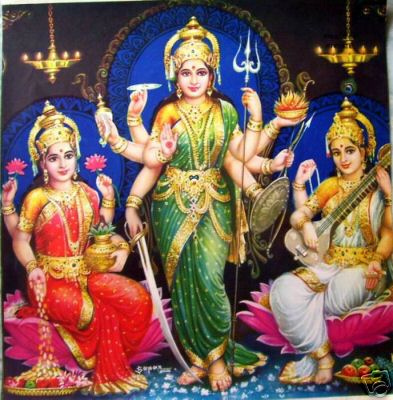Why is Sharad Navratri Devi Pooja with Durga Saptashati or Chandi Paath Special?
Not only in India but in most of the cultures that trace their origins in ancient civilizations energy has been considered to be Feminine. ” Devi” the divine energy manifests in many forms. Of the various forms of energy the manifestation in form of mother is very special. That is why the sages say:
या देवी सर्व भूतेषु मातृ रूपेण संस्थिता !
नमस्तस्यै नमस्तस्यै नमस्तस्यै नमो नम: !
We bow (do our namaskaaras) to that energy that is present in the physical forms of all beings as the “Mother”. This is because mother embodies all that is noble. She is live manifestation of unconditional love; full of compassion; the first teacher; and the best advocate of each one of her children. The Divine mother is mother of all beings in this universe. Hence she is referred to as “Jagat Janani” (the “Janani” = “mother” of entire Jagat. “Jagat” = all that is ever changing i.e. this external world). Being the mother of entire world she gives what is best for each one of children at any given time. Sometimes it is bitter medicine and other times it is gentle encouragement in face of obstacles.
Adi Shankara poetically says “कुपुत्रो जायेत क्वचिदपि कुमाता न भवति” . He says a son may turn out to be bad but a mother can never be a bad mother, because she always wants the best for her child.
There are 64 very powerful places in India that are referred to as “Shakti Peethas” (energy centers) where Divine mother is worshipped following many different traditions. These Shakti Peethas are spread all over the country from from Kanyakumari in South to Kashmir in North; and from Bengal in East to Sourashtra in West. Hence worship of Devi is common amongst all Hindus.
The Saptashati or Chandi, also known as The Devi Mahatmya forms part of Markandeya Purana, which is one of the oldest Puranas. It consists of 700 verses extolling the various aspects of Devi in 13 Chapters. Indian religious tradition by common consent bestowed to this book, the status of a scripture of the highest sanctity. The text is of deep soul-stirring value in which the supreme principle of Reality has been evoked and glorified under the name of Devi. This is an elaboration of the concept of Devi of the Vedic doctrine, an all-powerful Goddess of Supreme transcendence. Divine mother herself states in the 12th Chapter of Durga Saptashati, what is the best time to perform Pooja? and how to best perform it? She says
“शरत्काले महापूजां क्रियते या च वार्ष्की !
तस्यां ममैतत् माहात्म्यं श्रुत्वा भक्ति समन्वित: !”
Those who are full of devotion and listen to my glories described in “Durga Saptashati”, during an annual grand prayer ceremony (Varshiki =annual MahaPooja = Grand prayer ceremony) performed in Sharad Ritu (Autumn), to them Divine mother gives the boon that she will destroy all the problems that may arise in the life of such devotees. As a result of performing the Pooja of Devi during Navaratri, students gain knowledge; worldly people get happiness and all their worldly needs are fulfilled; amongst couples a strong bond of love and respect develops; amongst family members, the family ties strengthen and they become more united; individual suffering from diseases gains health; business people reap good profits in their business. Lastly but not the least a devotee who worships divine mother with severe austerities as prescribed in Durga Saptashati, will certainly attain the highest royal status is a boon granted by mother.
PH: 703-327-4774

